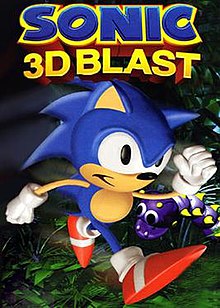Sonic 3D: Flickies' Island
| Sonic 3D Blast | |
|---|---|

North American cover art
|
|
| Developer(s) |
Traveller's Tales Sonic Team |
| Publisher(s) | Sega |
| Director(s) | Takao Miyoshi |
| Producer(s) | Kats Sato Yoji Ishii Yutaka Sugano |
| Designer(s) | Takao Miyoshi Kats Sato Kenji Ono Takashi Iizuka Hirokazu Yasuhara |
| Programmer(s) |
Sega Genesis Jon Burton Sega Saturn Neil Harding Stephen Harding |
| Artist(s) | James Cunliffe |
| Composer(s) |
Sega Genesis Jun Senoue Tatsuyuki Maeda Sega Saturn Richard Jacques |
| Series | Sonic the Hedgehog |
| Platform(s) | |
| Release | Sega Genesis Sega Saturn Microsoft Windows |
| Genre(s) | Platform, action |
| Mode(s) | Single-player |
| Aggregate score | |
|---|---|
| Aggregator | Score |
| GameRankings | 67% (Sat) 59% (Gen) |
| Review scores | |
| Publication | Score |
| EGM | 7.25/10 (Gen) |
| GameSpot | 7/10 (Sat) 5.6/10 (PC) 4/10 (Gen) |
| IGN | 6/10 (Gen) |
| Nintendo Life | 6/10 (Gen) |
| Entertainment Weekly | B (Gen) C (Sat) |
Sonic 3D Blast is a 1996 platform video game developed by Traveller's Tales and Sonic Team, and published by Sega for the Sega Genesis, Sega Saturn, and Microsoft Windows. Part of the Sonic the Hedgehog series, the game abandons previous Sonic games' side-scrolling style in favor of isometric gameplay, making use of some pre-rendered 3D models converted into sprites. The game features creatures known as Flickies, which first appeared in the 1984 arcade game Flicky. Controlling Sonic the Hedgehog, the player's goal is to collect Flickies and lead them to safety, periodically sparring with the series antagonist Dr. Robotnik, who is imprisoning them within robots.
The game was developed alongside another Sonic game for the Sega Saturn, known as Sonic X-treme, which was stuck in development hell. While Sonic 3D Blast was created for the Genesis as a swan song for Sonic on the system, Sega also commissioned a port for the Saturn as a backup plan in case X-treme could not be released, a plan that was moved forward on upon the cancellation of X-Treme in 1996. Sonic 3D Blast received mixed reviews from critics, who generally disliked its isometric gameplay but praised its visuals and music. The game was later ported in 1997 to Microsoft Windows computers and re-released on numerous Sonic themed compilations and digital distribution platforms. A similarly titled game, Sonic Blast, was released in the same month for Sega's Game Gear handheld console, though the games had different gameplay, plot, and a separate development team.
...
Wikipedia
